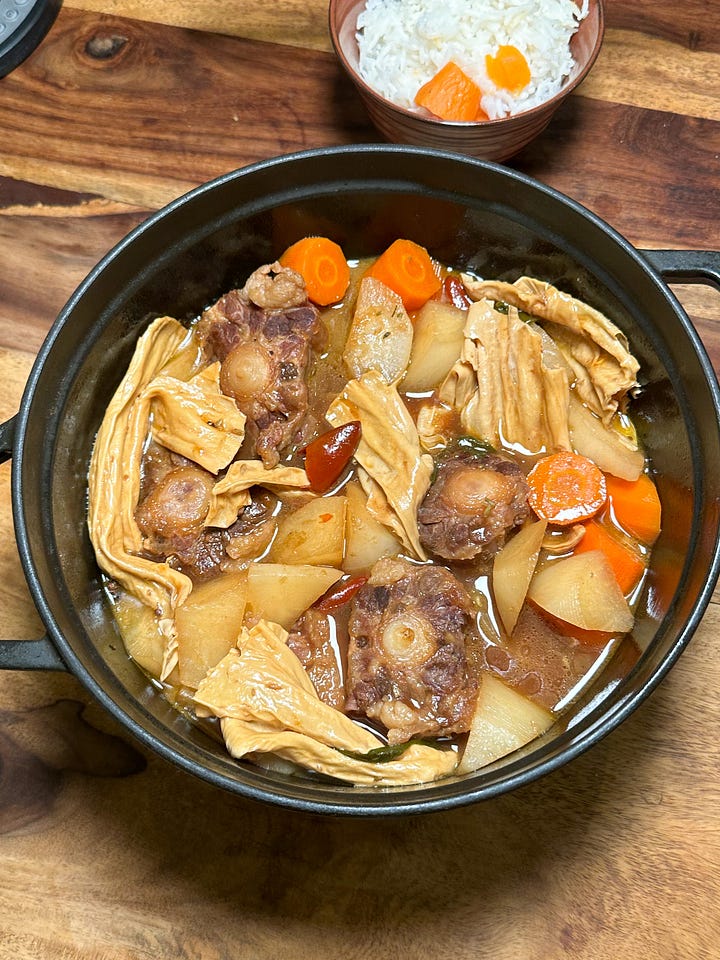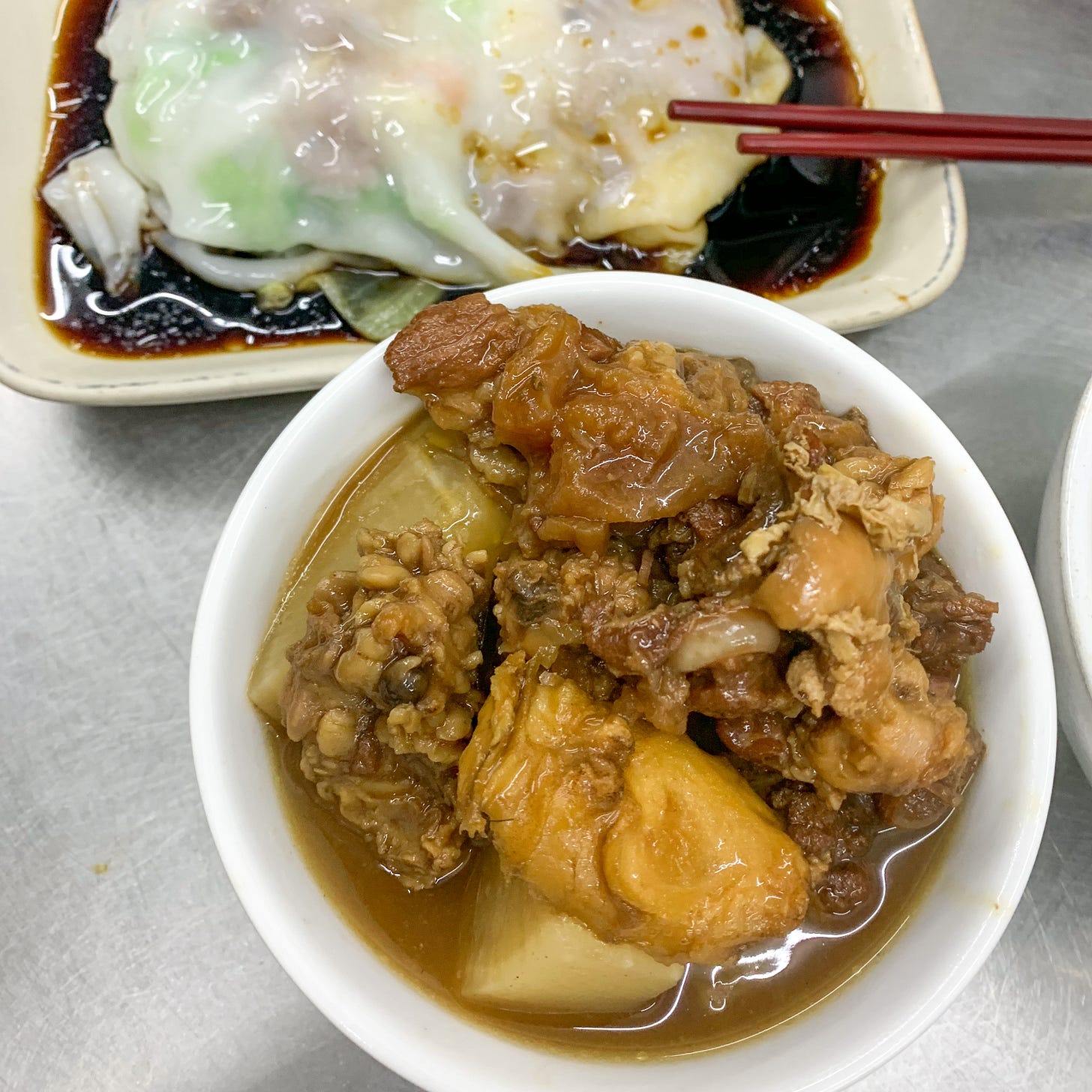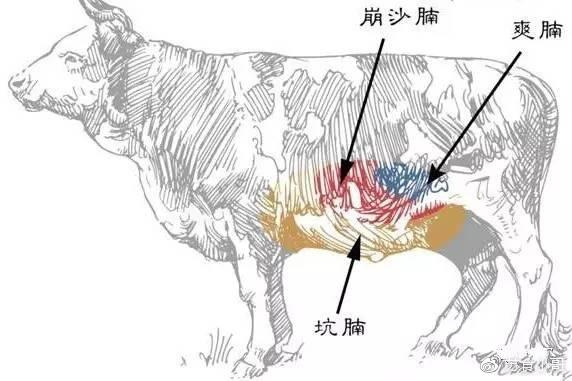Beef Stew with Daikon Radish and Tofu Skin
A Cantonese-style stew that features two great tofu products!
While researching and filming the second part of my guide on how to cook with tofu a few weeks ago, I came across a beef stew recipe that uses not just one, but two tofu products—fermented tofu in the sauce and dried tofu skin as a main ingredient. Talk about killing two birds with one stone when you're trying to showcase lesser-known tofu products like these. And, it’s fitting for the season.
Beef stew is enjoyed across China, but one of the most popular versions hails from the Cantonese region. Known as niunan bao (牛腩煲) or wen niunan(炆牛腩)1, it starts with blanching the beef and then slowly stewing it for hours in either a rich, spiced broth or a clear broth. You’ll find it served over noodles, with rice, or even as a street snack. Daikon radish is a classic addition—this pairing, called luobo niunan (萝卜牛腩), according to Sheng Hui’s book Notes on Cantonese Cuisine2, it was first invented near the Huaisheng Mosque in Guangzhou. Another version features dried tofu skin, known as fuzhu niunan (腐竹牛腩).
For my recipe, I combined both daikon—because winter is the best season for it—and tofu skin for extra texture. That being said, you can swap in carrots, potatoes, fried tofu, or even keep it simple with just beef.
The reasons to love a good beef stew are obvious: it’s made with affordable beef cuts, it’s perfect for batch cooking, and with just a few hours of passive cooking in a clay pot or Dutch oven, you get a pot full of flavor and comfort that pairs with almost anything, think rice, noodles and rice noodles. In the past, I often made a Sichuan-style beef stew I grew up with, using dried chili and doubanjiang. But as I’ve grown older, my palate has expanded to include less spicy foods, and this Cantonese version is milder but just as flavorful. The fermented tofu adds umami, creaminess, and a beautiful red hue to the sauce. Staying traditional, I also got my hands on chu hou paste, a classic braising paste in Cantonese cuisine made from soy beans. I’ve included a few options to substitute this in the tips section.
Recipe: Beef Stew with Daikon Radish and Tofu Skin / 萝卜腐竹牛腩
Servings: 2-3
Ingredients
450 g (1 lb.) beef
60 g (2 oz.) dried tofu skin (stems or knots)
250g (0.5 lb)daikon radish
4 thick slices of ginger
2 garlic cloves, peeled and crushed
1 small red onion, roughly chopped
1 tbsp fermented tofu (furu)
2 tbsp Chinese five-spice paste/chu hou paste (or substitute with 2 tbsp soy bean paste + 1/4 tsp five-spice powder; see note)
1 tbsp Shaoxing wine
1 tbsp rock sugar or white sugar
1 tbsp light soy sauce
1 tsp dark soy sauce
1/4 tsp salt (or more to taste)
500–600ml hot water or broth
Spices: 1/2 tsp Sichuan pepper, 1 bay leaf, 1 star anise, 1 small piece of cinnamon stick, 1 tsp whole white pepper
Cilantro for garnish
Instructions
Cut the beef into large chunks (about 3 cm / 1.2 inch). Place in a pot with cold water and 2 slices of ginger. Bring to a simmer, skim off any foam, and cook over medium heat for about 10 minutes. Remove the beef, rinse off any residue, and drain completely. Fitler, and reserve the cooking liquid to use as broth if desired.
Soak dried tofu skin in lukewarm water for at least an hour, until soft. Meanwhile, cut the daikon radish into large chunks. Mix fermented tofu, chu hou paste (or its substitute), and Shaoxing wine until smooth.
In a Dutch oven or clay pot, heat 1 tbsp vegetable oil over medium heat. Add the red onion, garlic, and remaining ginger slices, and fry briefly until fragrant. Add the sauce mixture and fry briefly.
Add the beef pieces to the pot and stir to coat them in the sauce. Sprinkle in the sugar and mix well. Deglaze the pot with hot water or the reserved broth, and bring to a simmer. Add the spices, and season with light soy sauce, dark soy sauce. Cover with a lid and simmer over medium-low heat for at least 1 hour.
Taste the broth and season with salt. Add the daikon radish and softened tofu skin to the pot. Continue to stew with lid on for another 30 minutes to 1 hour, or until all ingredients are tender. The beef should be soft enough to pierce easily with chopsticks. Garnish with cilantro. Serve with rice or over noodles.
Tips for Making This Recipe
What beef cuts should I use?
Traditionally, niu nan (牛腩) is used. This cut is translated to rough flank (flank with tough tissues and tendon) in English but could refer to the whole flank, plate and brisket area. In Guangdong, there’re even more specific sub-cuts of niu nan (see photo below). If you can’t find this, choose any affordable, slightly fatty cut like shank, short ribs, chuck roast, or even ox tails (they taste amazing). In Germany I don’t have access to rough flank, so I usually opt for Suppenfleisch (soup meat), which varies but often includes brisket or pot roast. Look for pieces with some fat and tendon to ensure juicy, tender meat.
What is Chinese five-spice paste?
Chu hou paste (柱侯酱), or zhouhoujiang in Mandarin, translated to Chinese five spice paste, is a fermented soybean paste flavored with five-spice powder, garlic, ginger, and sesame. It’s a classic Cantonese braising ingredient, often available at Asian grocery stores (Lee Kum Kee is the most accessible one). If you don’t have it, substitute with 2 tablespoons of soybean paste plus five-spice powder. Alternatively, you could use hoisin sauce suggested by wok of life, or even skip it entirely—just increase the soy sauce slightly, or add 1–2 teaspoons of doubanjiang for a spicier flavor.
Can we save some time?
In general the beef needs to be stewed in the pot for at least 1.5 hours. For a quick weeknight dinner, use fresh or frozen thinly sliced beef (like what’s used for hot pot or sukiyaki). Make the stew base with daikon and tofu skin first, then add the beef slices just before serving to cook them through quickly. Or use a pressure cooker or instant pot.


Another daikon stew recipe from last year’s winter solstice:
Winter Solstice Lamb and Daikon Radish Stew
In Sichuan we celebrate winter solstice by eating a warming lamb stew (羊肉萝卜汤) with family. Here's my attempt to recreate it!
炆 (wen in Mandarin or man in Cantonese) is a Cantonese cooking term that refers to cooking over low heat. This word captures the essence of the method more accurately than the generic term we typically use for braising in Chinese (烧). Michelin guide has an article about this Cantonese method.
“萝卜牛腩是广州的传统小吃,它的历史可以追溯到唐代,最早诞生在光塔寺附近。”—《粤菜记》 盛慧








